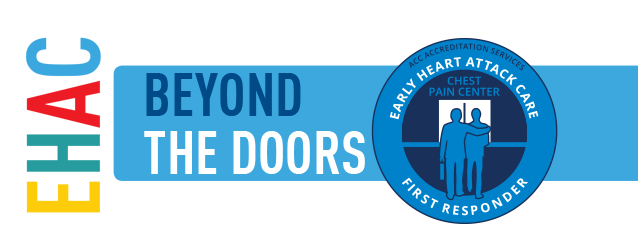EHAC Articles

Beyond the Doors of a CPC
Dr. Ray Bahr is more than just the Founder of ACC Accreditation Services. His Early Heart Attack Care program is a benchmark of community outreach and education for heart disease.
(This article was originally published in 2012 and has been updated to reflect the March 2018 EHAC Pledge numbers)
As we recently achieved 850,000+ pledges, we know it started with a question, "Do we need a chest pain center?" The answer is a resounding yes because it helps hospitals show that they care about the health of their community. But it's more than the life-saving technology and skills that are a requirement of any CPC. As part of the accreditation process, hospitals tackle the spectrum of heart health by using the Early Heart Attack Care (EHAC) education that is created by the Society.
Everyone knows that 800,000 people die from heart attacks each year. And if they don't die, a patient's life rarely returns to pre-event levels. The accreditation process enables a hospital to spread the message outside of their walls in order to create new lines of communication within their community.
Why is this so Important?
Heart attacks begin in the community and they fester in the community. The pathophysiology of a heart attack is well known in the medical field. The heart vessel (coronary) that supplies needed oxygen and nutrients to the heart muscle is being interfered with. What is occurring is a rupture and tear in an area of the heart vessel that has a build up of fatty cholesterol-rich material and starts to undergo changes that cascade until the heart vessel is completely closed by clot formation. .
The patient either dies (cardiac arrest) or is in severe pain and gasping for breath. Medical care here at this point is truly an emergency! The patient needs to get into the hospital as soon as possible to get this closed vessel opened with drug clot busters or a catheterization wire. The chances of having this done within the time that will save the majority of the heart muscle involved are not too good. Such Emergency Heart Attack Care is Late Heart Attack Care.
Does Early Heart Attack Care exist and How Can it be Harnessed?
Not all heart attacks are created equal. Some occur abruptly and some occur over time. The some that occur over time vary, but in many cases this may be hours to sometimes days in which the chest discomfort symptoms are mild and come and go. We refer to this as the "stuttering effect" of the heart attack. This is "the grace period" in that very little heart damage is taking place. Intervention here can be very effective. The problem here is that the events are taking place in the community.
Think about this for a moment.
The person (not yet a patient) is off and running like most of us, on our own treadmills and tasks to accomplish before the end of the day…..and then, this discomfort comes……resting allows it to go away….the person says to himself "I don't look sick!" "I am not giving away the fact that I am having trouble" (important as peer pressure is lacking)……..and this goes on….and precious time is being lost.
This is the most important time to intervene.
A life can be saved. The heart muscle can be prevented from having damage. The Heart coronary vessel can be fully opened and drugs given to prevent further clot formation. Last but not least, this becomes a "teachable moment" and now it is possible to get the person to listen to primary risk factors reduction for added prevention to take place.
Why is it so important to have an accredited Chest Pain Center in your Hospital?
Your hospital can join with others in an effort to significantly reduce heart attack deaths in the United States. The Chest Pain Center becomes the Ambassador for setting up operations that will put the EHAC approach into place. It does this by setting up a standardized comprehensive approach for management of patients with heart attacks, but with emphasis on the pathway for recognition of patients with early heart attack symptoms.
This new system will allow for patients with mild chest symptoms to be sorted out in a cost-effective way using an observation unit and discharging safely 85% of the patients seen within 24 hours. The remaining 15% represent the capture of patients early and preventing death and damage from taking place. If you don't have a chest pain center in your hospital, then you lose out and your community loses out on becoming a part of the early care solution.
As one Chief Executive Officer once told me, "This is the right thing that we can do for our Community and we are going to do it!"
Best of Luck in Saving A Life,
Raymond D.Bahr MD
EHAC Articles by Dr. Raymond Bahr
- A Tribute: Dr. Bobby Brown
- One Mission Requires Many Partners
- Inspiration on a Mission: Science of Peace Lecture
- Beyond the Doors of a CPC
- EHAC Expansion to Include Hospital Employees
- February is Heart Month
- He Declared War on Heart Attacks
- Amazing Results in EHAC
- Finding the Rosetta Stone
- Are you a Saver or an Enabler?